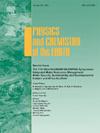Water reservoirs quality management using meta-heuristic Algorithms: Analysis and optimization of water quality considering uncertainties
IF 3
3区 地球科学
Q2 GEOSCIENCES, MULTIDISCIPLINARY
引用次数: 0
Abstract
Managing reservoir water quality under uncertainty remains a critical challenge in contemporary water resource management. This study introduces a robust simulation–optimization meta-model framework to enhance reservoir outflow quality, focusing on minimizing Total Dissolved Solids (TDS) concentrations. To circumvent the computational limitations of high-fidelity simulators, a Supervised Learning (SL) surrogate model was developed as a substitute for the CE-QUAL-W2 simulator. Achieving a prediction accuracy of 85 %, the SL model effectively captures complex, nonlinear interactions within water quality dynamics. Two hybrid metaheuristic frameworks—Particle Swarm Optimization integrated with SL (PSO-SL) and Enhanced Vibrating Particle System integrated with SL (EVPS-SL)—were implemented to optimize reservoir outflows under uncertainty. Both approaches successfully balanced the competing objectives of meeting downstream water demand and minimizing TDS concentrations, while significantly reducing computational costs and improving convergence behavior. The rigorously calibrated CE-QUAL-W2 model demonstrated high validation scores (NSE = 0.99 for storage volume and 1.00 for water level; PBIAS = −0.05 % and −0.0004 %, respectively), confirming its reliability for surrogate training. Additionally, the study examined uncertainty propagation using two widely adopted sampling techniques: Monte Carlo Simulation and Latin Hypercube Sampling (LHS). Optimization outcomes were assessed using performance metrics—reliability, vulnerability, and resilience. The PSO-SL model, coupled with Monte Carlo sampling, exhibited the most balanced performance, achieving 41 % reliability and 26 % vulnerability. In contrast, EVPS-SL with LHS demonstrated faster convergence (30 % reduction in computational time) but yielded lower reliability (16 %) and higher vulnerability (87 %). This research not only advances reservoir water quality management under uncertainty but also contributes methodologically to the integration of data-driven surrogates and optimization within environmental systems modeling.
基于元启发式算法的水库水质管理:考虑不确定性的水质分析与优化
在不确定的情况下管理水库水质仍然是当代水资源管理的一个关键挑战。本研究引入了一个强大的模拟优化元模型框架,以提高水库流出水质量,重点是最小化总溶解固体(TDS)浓度。为了规避高保真模拟器的计算限制,开发了一个监督学习(SL)代理模型作为ce - quality - w2模拟器的替代品。达到85%的预测精度,SL模型有效地捕获了水质动力学中复杂的非线性相互作用。采用混合元启发式框架-结合粒子群优化(PSO-SL)和增强振动粒子系统(EVPS-SL)对不确定条件下的油藏流出进行优化。这两种方法都成功地平衡了满足下游用水需求和最小化TDS浓度的竞争目标,同时显著降低了计算成本并改善了收敛行为。经过严格校准的ce - quality - w2模型具有较高的验证分数(存储体积NSE = 0.99,水位NSE = 1.00);PBIAS分别= - 0.05 %和- 0.0004 %),证实了其对代理培训的可靠性。此外,该研究使用两种广泛采用的采样技术:蒙特卡罗模拟和拉丁超立方体采样(LHS)来检验不确定性传播。使用性能指标(可靠性、脆弱性和弹性)评估优化结果。结合蒙特卡罗采样的PSO-SL模型表现出最平衡的性能,达到41%的可靠性和26%的脆弱性。相比之下,具有LHS的EVPS-SL收敛速度更快(计算时间减少30%),但可靠性较低(16%),脆弱性较高(87%)。该研究不仅推动了不确定条件下的水库水质管理,而且在方法上为环境系统建模中数据驱动替代和优化的集成做出了贡献。
本文章由计算机程序翻译,如有差异,请以英文原文为准。
求助全文
约1分钟内获得全文
求助全文
来源期刊

Physics and Chemistry of the Earth
地学-地球科学综合
CiteScore
5.40
自引率
2.70%
发文量
176
审稿时长
31.6 weeks
期刊介绍:
Physics and Chemistry of the Earth is an international interdisciplinary journal for the rapid publication of collections of refereed communications in separate thematic issues, either stemming from scientific meetings, or, especially compiled for the occasion. There is no restriction on the length of articles published in the journal. Physics and Chemistry of the Earth incorporates the separate Parts A, B and C which existed until the end of 2001.
Please note: the Editors are unable to consider submissions that are not invited or linked to a thematic issue. Please do not submit unsolicited papers.
The journal covers the following subject areas:
-Solid Earth and Geodesy:
(geology, geochemistry, tectonophysics, seismology, volcanology, palaeomagnetism and rock magnetism, electromagnetism and potential fields, marine and environmental geosciences as well as geodesy).
-Hydrology, Oceans and Atmosphere:
(hydrology and water resources research, engineering and management, oceanography and oceanic chemistry, shelf, sea, lake and river sciences, meteorology and atmospheric sciences incl. chemistry as well as climatology and glaciology).
-Solar-Terrestrial and Planetary Science:
(solar, heliospheric and solar-planetary sciences, geology, geophysics and atmospheric sciences of planets, satellites and small bodies as well as cosmochemistry and exobiology).
 求助内容:
求助内容: 应助结果提醒方式:
应助结果提醒方式:


